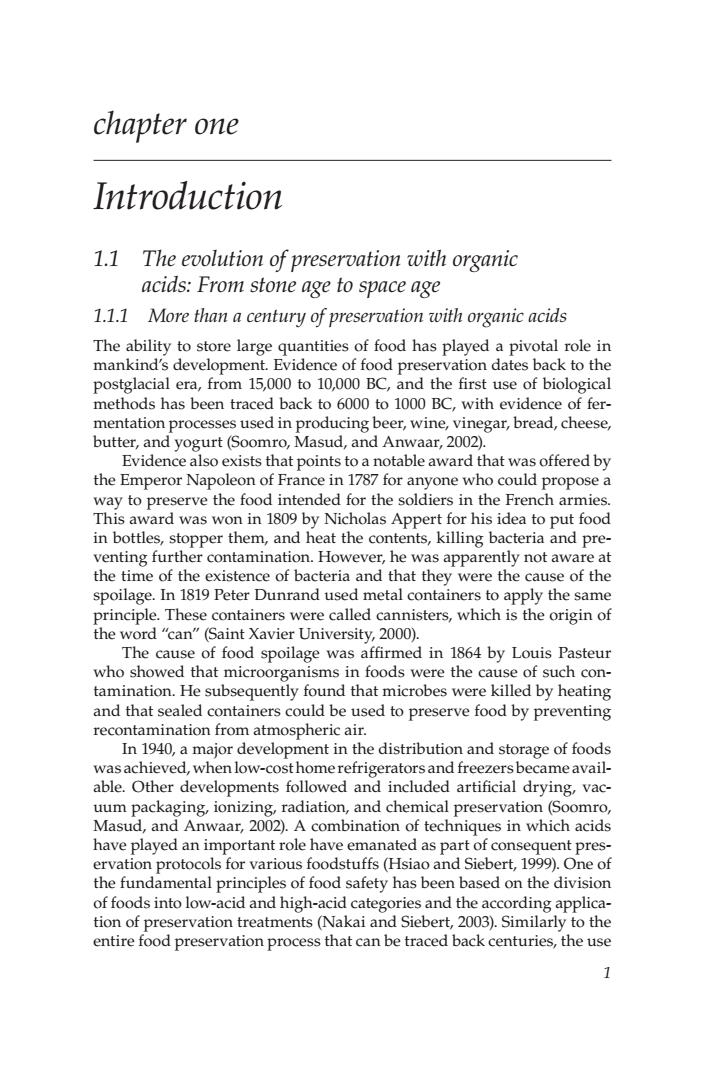正在加载图片...

chapter one Introduction 1.1 The evolution of preservation with organic acids:From stone age to space age 1.1.1 More than a century of preservation with organic acids The ability to store large quantities of food has plaved a pivotal role in vation dates back to the d the first use of biological ods has b een traced back with ev der e of fer mentation process s used in producing beer,wine,vi egar,bread,cheese, butter,and yogurt(Soomro,Masud,and Anwaar,2002 Evidence also exists that points to a notable award that was offered by the Emperor Napoleon of France in 1787 for anyone who could propose a way to preserve the food intended for the soldiers in the French armies. This award was won in 1809 by Nicholas Appert for his idea to put food in bottles,stopper them,and heat the contents,killing bacteria and pre- venting further contamination.However,he was apparently not aware at the time of the existence of bacteria and that thev were the cause of the Pollage In 1819 Peter Dunrand used metal containers to apply the same ntainers w e called the origin rd can"(Saint Xav ier Iniv The of fo sity,2000) e was d in 1864 by Louis Pasteur who we dthat microor s were the ca such nation. sequently f and that sealed containers could be used to preserve food by preventing recontamination from atmospheric air. In 1940.a maior development in the distribution and storage of foods was achieved,when low-cost home refrigerators and freezers became avail- able.Other developments followed and included artificial drving.vac. uum packaging,ionizing,radiation,and chemical preservation(Soomro Masud,and Anwaar,2002).A combination of techniques in which acids have played an important role have emanated as part of consequent pres rotocols for various foodstuffs (Hsiao and Siebert.1999).On the fundamental principles of food safety has been based on the division of foods into lo acid and high- and th on of preservation trea tments (Nakai 20 applica- to the entire food preservation process that can be traced back centuries,the use 1 1 chapter one Introduction 1.1 The evolution of preservation with organic acids: From stone age to space age 1.1.1 More than a century of preservation with organic acids The ability to store large quantities of food has played a pivotal role in mankind’s development. Evidence of food preservation dates back to the postglacial era, from 15,000 to 10,000 BC, and the first use of biological methods has been traced back to 6000 to 1000 BC, with evidence of fermentation processes used in producing beer, wine, vinegar, bread, cheese, butter, and yogurt (Soomro, Masud, and Anwaar, 2002). Evidence also exists that points to a notable award that was offered by the Emperor Napoleon of France in 1787 for anyone who could propose a way to preserve the food intended for the soldiers in the French armies. This award was won in 1809 by Nicholas Appert for his idea to put food in bottles, stopper them, and heat the contents, killing bacteria and preventing further contamination. However, he was apparently not aware at the time of the existence of bacteria and that they were the cause of the spoilage. In 1819 Peter Dunrand used metal containers to apply the same principle. These containers were called cannisters, which is the origin of the word “can” (Saint Xavier University, 2000). The cause of food spoilage was affirmed in 1864 by Louis Pasteur who showed that microorganisms in foods were the cause of such contamination. He subsequently found that microbes were killed by heating and that sealed containers could be used to preserve food by preventing recontamination from atmospheric air. In 1940, a major development in the distribution and storage of foods was achieved, when low-cost home refrigerators and freezers became available. Other developments followed and included artificial drying, vacuum packaging, ionizing, radiation, and chemical preservation (Soomro, Masud, and Anwaar, 2002). A combination of techniques in which acids have played an important role have emanated as part of consequent preservation protocols for various foodstuffs (Hsiao and Siebert, 1999). One of the fundamental principles of food safety has been based on the division of foods into low-acid and high-acid categories and the according application of preservation treatments (Nakai and Siebert, 2003). Similarly to the entire food preservation process that can be traced back centuries, the use